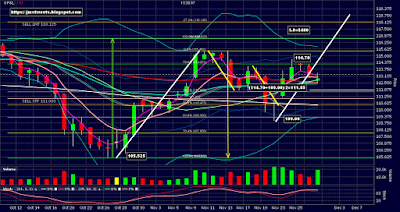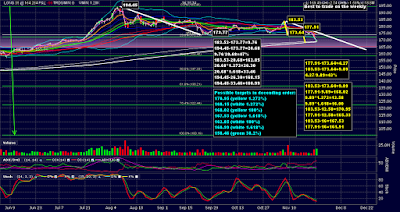The full size EUR/USD futures contract is $12.50/pip. The minimum tick (price increment) is half of a pip (0.00005). The symbol on Interactive Brokers is EUR.
The mini size is $1.25/pip. The minimum tick (price increment) is one pip (0.0001). So the mini is 1/10th the size of the full contract, which of course means you need 10 mini's to represent the same position change as the full contract. The symbol on Interactive Brokers is M6E.
The mini has much less volume than the full contract. For example, as I write this at 12:22am ET, the full size EUR Dec Futures has 627K volume, whereas the mini has volume of 12.8K. The other disadvantage is the minimum tick (price increment). The full contract has a resolution down to a half a pip, while the mini has a minimum tick of a full pip. These 2 disadvantages are true for many, if not most or all, of the full/mini futures pairs.
However, there are 2 wonderful advantages of having the mini contracts. Scaling and Hedging.
Scaling is starting a position with a small entry and adding more contracts as price action moves in your favor. You can do the same on the way out of the trade by taking contracts off as you hit sequential targets. Scaling keeps your loss lower if the trade goes against you and hits your Stop. It also enables you to let your trade run by taking off just a partial position rather than your whole position when you hit the closest target.
Hedging is taking a different position in the opposite direction for protection rather than exiting your trade, as you would with a Stop. This is what I did today. It worked well and I'll discuss it next.
The setup is based on the yellow range on the chart above. Price had just hit the 61.8% of the green range (partially shown) and took a little dip down to the 38.2% Fib of the yellow range, then bounced off and rose to breakout to the upside at point labeled "A". This setup has the yellow 61.8% Fib Extension as the target and the bottom of the yellow range as a Stop.
When you dip down to a retracement not as far as the 50% level and bounce back up and break out, that usually means one of two things. Either you have very strong momentum, so much so you couldn't dip down to the 50%, which is much more common than just the 38.2%, in my experience, or you have a false break out and you're going back down to the 50% or maybe the 61.8% or even lower.
I wasn't sure which one of these 2 likely situations I was in. If we dipped back in to go hit the 50% level then I felt pretty confident we'd reverse and eventually hit the yellow 61.8% Extension target. Notice the 61.8% yellow extension is in confluence with the 161.8% Fib Extension of the green range. That makes this a likely target.
So I wanted to give the trade a chance to work, and therefore not exit until the proper Stop was hit. But I entered long with the full contract at 1.18975. The Stop was just under the yellow range at 1.18340. That's a potential loss of 1.18975 - 1.18340 = 63.5 pips x $12.50/pip = $793.75. That was doable but the profit potential was 1.19270 (Target) - 1.18975 = 29.5 pips x $12.50/pip = $368.75. That's a terrible Risk:Reward and I really didn't want to put on that trade on a Friday during this very volatile time of being in the middle of determining who won the Presidential election, Covid cases getting worse, and more. I reference the headline risk because the wrong headline from the USA or Europe could drive the price straight down and fast.
My solution was to use hedging. After the breakout and the Buy Stop order was triggered to buy 1 full contract, I entered the following order using the mini contract:
Sell Stop 10 M6E at 1.18870, with a Buy Limit order at 1.18340. Remember 1.18340 was my Sell Stop for the Full contract. I also staged an order, a Buy Stop for 10 M6E at 1.18870. This staged order was to exit the hedge on the way back up.
This hedge would lock in a maximum loss of 1.18975 - 1.18870 = 10.5 pips x $12.50/pip = $131.25. This works because as the Full contract is losing value when price is falling, the mini position is gaining value. Even if price fell all the way down to the Full contract Stop, and we exited both the Full and mini positions, the loss would still be only $131.25. Remember, without the hedge the loss would be $793.75.
So, as you can see on the chart, price did an abrupt turn around and fell hard. The hedge was triggered at "B" on the chart and I went Short 10 mini contracts at 1.18870. Once I was significantly below the staged hedge exit order, I submitted it. Then price hit the yellow 50% Fib retracement and went down a little further, almost hitting the yellow 61.8% Fib. After that price started running back up.
The original plan was to let the hedge exit order take off the hedge for a break even. But at point "C" on the chart I was confident enough to take off the hedge at 1.18770, yielding a profit of 1.18860 - 1.18770 = 9 x $12.50 = $112.50 from the hedge.
As you can see, price continued up and into a positive position. Since we already hit the 50% Retrace and came all the way back up, there is no good reason, in a healthy trade, to take a leg back down. So no need for a hedge. Instead I can just use a tight stop. Which was hit at the point labeled "D".
I ended up with a small profit. Now I see volume is fading and time until the end of the trading week is not far off on a 15 minute chart. I expect volume to continually fade and candles to continually shrink. So I will watch the chart but probably won't re-enter this trade.
The bottom line is that hedging was a great solution and worked as expected. Even better actually. And it wouldn't have been possible without the mini sized futures contract.









